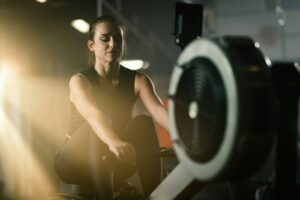
Incorporating rowing into your cross-training routine provides a well-rounded mix of cardiovascular, strength and flexibility advantages, making it a valuable component of any fitness plan. This article will discuss the perks of rowing, outlining the technique and offering actionable tips on how to blend rowing into your current workouts seamlessly.
Getting to Know the Basics of Rowing

Rowing is a full-body exercise that targets multiple muscle groups simultaneously, offering a balanced routine that can enhance stamina, strength, and coordination. It is an activity that engages the back, legs, arms and core, all while being low-impact, reducing the risk of injury associated with high-impact sports.
Selecting the Right Rower: Picking the appropriate rowing machine is essential. Air rowers mimic the natural resistance of water and are favoured for their smooth action. Magnetic rowers provide resistance levels and operate quietly—ideal for shared living spaces. Hydraulic rowers are budget-friendly options, suitable for those with limited space.
Rowing Equipment: Investing in a quality rowing machine is key. Additionally, wearing form-fitting attire can prevent snags, while proper footwear will support your feet during leg movements.
The Technicalities of Rowing Technique
A correct rowing technique is essential not just for an effective workout but also to avoid injury.
- The Catch: Begin with your knees bent and lean forward from the hips, arms reaching forward, and hands gripping the handle.
- The Drive: Initiate the stroke with a powerful leg push, leaning back and pulling the handle towards your chest.
- The Finish: Conclude the stroke by leaning back slightly, handle pulled to the lower ribs, and the elbows drawn back.
- The Recovery: Extend your arms forward, hinge from the hips to lean forward, and then bend your knees to glide forward.
Common mistakes include rounding your back, pulling with the arms prematurely, and hurrying through the recovery phase. Steering clear of these slip-ups guarantees a safer workout.
Tracking Your Fitness Journey
Rowing machines provide various metrics to monitor your progress—like stroke rate, time and total distance. Grasping these metrics helps you establish goals that you can work towards achieving—whether it is improving your 500-metre split time or boosting your stamina.
Incorporating Rowing into Your Cross-Training Routine
Rowing supplements training methods by injecting some variety into the mix and pushing your body in new ways.
- Endurance Rows: These longer sessions (20-30 minutes) at a moderate pace are perfect for building cardiovascular endurance.
- Interval Training: Mixing short, intense bursts of rowing with rest periods improves both speed and power.
- HIIT Sessions: High-intensity interval training on the rower can significantly boost metabolism and fat loss.
It’s crucial to balance rowing with strength training and other cardiovascular exercises to prevent overtraining and ensure a well-rounded fitness profile.
Advanced Rowing Strategies and Workouts
As you progress in rowing, challenge yourself by adjusting the length and intensity of intervals, modifying resistance levels and changing stroke rates. Experiment with pyramid intervals or sprint sessions with breaks to push your limits. Advanced strategies may include pyramid intervals, where you incrementally increase and then decrease the intensity and duration of your efforts, or performing sprints with minimal rest to maximise endurance and power output.
Rowing is an effective and dynamic way to elevate your fitness routine for individuals of all fitness levels. Proper technique, understanding progression metrics, and integrating rowing into your workout regimen can lead to significant improvements in fitness, offering a unique blend of endurance, strength, and flexibility benefits. The versatility of rowing makes it easy to customise workouts based on fitness objectives, ensuring a stimulating training routine. Begin your rowing adventure with eagerness. Witness the impact it can have on your overall fitness level. Whether you’re an expert or seeking to advance your skills, there’s always room for progress and development. Share your rowing experiences and achievements with a community that cheers on every stroke toward health. Consider joining a rowing class or consulting a fitness expert for guidance on reaching your potential. Rowing not only boosts wellness but also instils feelings of accomplishment and contentment after each session.
We encourage you to share your rowing journey with us. Whether it’s your progress, challenges, or any tips you’ve discovered along the way, your experiences can inspire and motivate others. If you’re new to rowing, consider signing up for a rowing class or consulting with a fitness professional to get started on the right foot. Embrace rowing as a key component of your cross-training routine and experience the benefits it brings to your fitness journey.
FAQ
How often should I include rowing in my workout routine?
For beginners, incorporating rowing 2-3 times a week allows for sufficient recovery time. As you become more accustomed, you can increase frequency based on your overall fitness goals and other training activities.
Is rowing good for building muscle?
Yes, rowing is a full-body workout that engages several major muscle groups, including the legs, back, arms, and core, helping to build muscle strength and endurance.
Can rowing improve cardiovascular health?
Definitely. Rowing is an excellent cardiovascular workout that can help improve heart health, increase lung capacity, and enhance overall cardiovascular fitness.
How long should a rowing session last?
The duration of a rowing session can vary based on fitness level and goals. Beginners might start with 10-15 minutes, while more experienced rowers may aim for 30-60 minutes.



